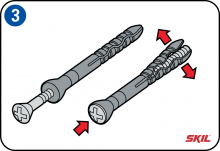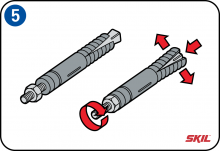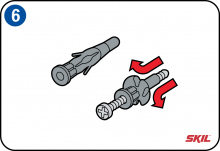-
What kind of wall plug should I use?
Each building material needs a specific kind of wall plug. Different kinds of wall plugs are available for special situations, and these often give a stronger mouting than universal wall plugs. After you’ve found the right kind of wall plug for the job, the next step is to choose the right size. The drill bit diameter is the same as the wall plug diameter. This is usually indicated on the wall plug, for example S6 for a wall plug and drill bit diameter of 6 mm.
-
Universal wall plugs
The classical nylon wall plug is available in different basic types. When you tighten the screw the wall plug expands, so it anchors itself firmly in the wall. Drill the hole with a hammer drill and tap the plug gently into place. Then you can fit the screw. Make sure you use a type of screw that is suitable for use with wall plugs, and that has the right length and thickness for the wall plug you’re using.
-
Hammer fixings
These wall plugs contain a steel nail or special screw which is driven into place in the plug with a hammer. This is a lot faster than using a conventional screw, and is ideal for fitting plinths, wooden beams, window frames, ceiling panels and wall cladding. If necessary you can tighten the screw with a screwdriver after driving it into place.
-
Butterfly wall plugs
These nylon wall plugs are intended for use in hollow walls and consist of 2 sections. When the screw is tightened, the back part of the plug is folded double towards the front of the plug. Another variant is the butterfly plug. This has 4 ‘wings’, and is ideal for mounting in shallow holes. You can use these wall plugs for hanging paintings, light mirrors and other light items. This kind of plug gives a strong grip in plasterboard and similar materials.
-
Anchor bolts
These wall plugs are intended for fixings that have to support heavy loads such as large shelves or racks. An M12 anchor bolt can usually support a load of up to 200 kg. When the nut or hook is tightened, the conical anchor is pulled inwards. The resulting pressure causes the metal segments to expand and press strongly against the surrounding material.
-
Plasterboard plug
This plug forms a thicker section inside or behind a hollow wall. When a screw is inserted and tightened the segments expand and fold out like an umbrella. These plugs can be used with different kinds of panels, and are also suitable for mounting light items on ceilings.
-
Toggle plug
Toggle plugs are mainly used in ceilings and hollow walls. They have spring-loaded ‘wings’ mounted on a screw thread. The plug is pushed through the hole with the wings closed. and these then spread out when they are released and the screw is tightened.







